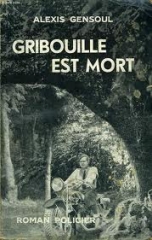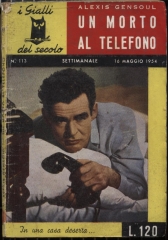(Article translated into English)
Alexis Gensoul : Un morto al telefono ( Gribouille est Mort , 1945) – A dead man on the phone, 1945 – I Gialli del Secolo, N.113 del 16 maggio 1954.
Today we speak about a completely unknown novel, published in 1954 by Gherardo Casini Editore in the great series of detective novels, “I Gialli del Secolo (=The Century “Yellow” Crime Novels Fiction)” that it should be said right away, go down in history for being abridged: it is novels in the file of just over 90 pages, two-column layout, as the old “Yellow” Novels Mondadori until the 80s, smaller font, showing authors and novels often forgotten now entered only in the memory of those who, like myself , is interested to know also and above all the unknown authors, even at the cost of reading other novels thrown.
At the Casini Publications, the covers are never original, but they are frames taken from famous movies of the time that the situation can recall the title of the novel: in our case, for example, ‘cover image is taken from “Red Snow”. The actor holding the phone is the great Robert Ryan, an unforgettable protagonist of the film mentioned above, one of the best noir of the ’50s, On Dangerous Ground (1951), by Nicholas Ray.
In these novels often descriptions of the atmosphere has been sacrificed in favor of the police bare fact: it can be an advantage or a disadvantage. We argued long ago on the Blog Mondadori just that, with respect to the translation of a Herbert Brean, and Luca Conti complained that the obviousness and simplicity in the Italian translation of the novel contrasted with the beauty of the original version. Now this feature is very often in Casini, who are nevertheless the only chance we have to acquire information about forgotten authors.
The novel in question is by Alexis Gensoul, French writer active after World War II and remembered even today in some circles for a wonderful Locked Room written in collaboration with Charles Grenier, La Mort vient de nulle part (1945) and for another written by him alone in the same year, 1945, L’Énigme de Téfaha.
It must have been a very fruitful 1945, end of the Second World War, in the production of Gesoul, because of the same year is also Gribouille est mort, translated by Casini with “Un morto al telefono (=A dead man on the phone)”
Alexis Gensoul whose biographical information absent, we only know he was a physician and that between 1945 and 1946 he published four novels from the same publisher STAEL, three in 1945 and one in 1946: the first of these was L’Énigme de Téfaha, which has a fairly simple Locked Room, the second work was written with Grenier that still stands as one of Locked Rooms signposting written after the war, the eastern third was Gribouille est Mort, a great novel with a crime impossible, the fourth novel more on the adventure, L’Affaire de la maison Faroux (1946).
Gribouille est Mort would be a Locked Room , if he had not the window opened, but all other conditions are impossible for the crime: sealed door, missing weapon, and above all, since that distinguishes this novel, the dead, Gréje, which prophesies the first his own death, writing the letter to an acquaintance of his, Godinet, and call and talk to a policeman friend of his, Corbellet, somewhat naive cop, when he was already dead, the house littered with false evidence and strange clues, and jokes, also. Additionally, there is such Ternaud, with yellow boots that everyone is looking because he was seen at the crime scene, outside the house, and then he ran away; out of the fencing off of the house there ‘s whole class of school that draws, and the instructor, Tresquat, is none other than the illegitimate son of the victim and sole heir to a fortune of two hundred thousand francs at the time: he obviously suspected, even if no one saw him jump over the fence, because at some point has moved away from his students with the excuse to go look for mushrooms in the forest; a mysterious person phoned the local police station from the house of Greje to denounce the murder, but not the murderess, and there is a nearby curious Gourgeot; then there is a weapon found by a policeman amateur Vérannes, before Corbellet, a gun for women, size small, still stuck with a piece of rope, and many characters that are the corollary: Police Commissioner Estreval unlucky in his moves, and which moreover has the his few successes to the collaboration of an underground Sherlock Holmes in the shadows, who signs his suggestions and his letters with a nickname alluding to Perspicax; and the judge Blacy who believes smart himself.
All Ternaud chase, then tried to charge Tresquat, then they find Ternaud and they should wish he proclaimed himself guilty for taking them off the embarrassment of an investigation that does not go forward, especially since the open window, the only possible escape of the murderer ,overlooks a small garden in front of which there’s the famous fence beyond which there are many small children playing draw, all witnesses of the fact that no one may have missed it. Yet the murderer has jumped from the window: There are his footprints in the ground. At some point there is a revelation: an acquaintance of the victim Godinet that will reveal something to the police, but as the best dramas, the precious witness is found at the bottom of a ravine in the burning car.
At this point we need to find the culprit and then a lot of reconstructions face again: Estreval tends to blame Ternaud, Vérannes frames no the murder but a spectacular suicide with a lot of crow flapping at the crime scene and crucial because you do not find a certain thing; and then at the end, Perspicax reveals how Ternaud was not murderer but blackmail, in his turn of the real murderer who is the least to be suspected.
Great test of skill of Alexis Gensoul in having created a novel that approaches the impossible and never cross it, vividly illustrating the French province and subtle psychology of the characters.
However, in this novel, I emphasize the dependence about the British detective novel: the Perspicax solution is identical to that of Evil Under the Sun, by Agatha Christie, novel written in 1941, in particular where the victim has made an agreement with his unknown associate with whom they want to play a joke to others, in pretending to be dead, only that the murderer is not expected by the victim and he murder the victim.
The final solution, fine, is opposed to the other two solutions (not less effective, particularly that of Vérannes): the killer, when killed Gréje, was motivated by revenge and Perspicax says in practice he should waive the right to designate him as the real murderer (felt against him “an instinctive sympathy and inexplicable”) if that had not spotted the second death, that of Godinet, so could not be acquitted. A choice that makes Perspicax more than one investigator, a real sort of executioner in the shadows, very close to Arsene Lupin by Maurice Leblanc.
Pietro De Palma
P.S.
For the benefit of fans of the detective novel, not Italian, I will say that the Yellow, in Italy, is the detective story par excellence. The term “Yellow” in the sense derives from the yellow cover of the first novels published in Italy, “The Yellow Book”, by Mondadori, in 1929, following the fashion that had spread from England and from the United States of America . Since then, because those novels Mondadori had an overwhelming success, the term “the Yellow Book” condensed itself in The Yellow. For derivation, many publishing houses arose like mushrooms on the success of Mondadori, called their books, Yellow, to engage the phenomenon Mondadori

